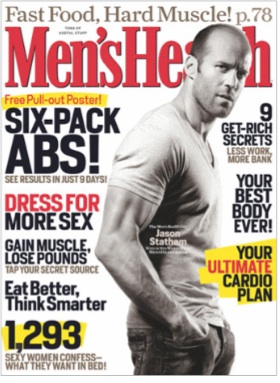Gender:
Horror- Females in horrors are usually subordinate and weaker. They are usually victims, helpless, and tormented by male villains. Males on the other hand are usually the more dominant, and are usually shown as either heroes or villains.
Themes:
Masculinity Blog
Thursday, 23 February 2012
Thursday, 2 February 2012
Test
1. What did Bly attribute as the role traditionally played by men in pre-industrial societies?
2. What is narcissism, and how is it related to masculinity?
3. How has the role that men have played in society changed over the years?
4. What characteristics are typically associated with the hegemonic male?
5. What force during the past century is largely responsible for making men feel guilty about their prior role in society?
6. What is an Oedipus complex and how does it relate to masculinity?
2. What is narcissism, and how is it related to masculinity?
3. How has the role that men have played in society changed over the years?
4. What characteristics are typically associated with the hegemonic male?
5. What force during the past century is largely responsible for making men feel guilty about their prior role in society?
6. What is an Oedipus complex and how does it relate to masculinity?
Monday, 30 January 2012
Men's Health and Nuts

This magazine seems to demonstrate male superiority. The man has his arm around the woman, which suggests that he is in the dominant role. The text helps confirm this. "Strength! Fitness! Power!" suggests that masculinity comes with some sort of power or ability. The line "One month to a body she can't resist" suggests that women are incapable of resisting sexual desire when it comes to men. However, the woman looks confident rather than helpless, and she is holding onto the man's arm as well, which may suggest more of a shared role between them, such as the type you may see among the new man.

This magazine shows some male narcissism, as the man looks confident and a male audience will try to identify themselves with him and will aspire to become more like him.
Thursday, 26 January 2012
Masculinity represented on Madmen
In the episodes, the society is still largely patriarchal, with men having a superior role to women. Despite this, the time period is one where men and women's roles are becoming more equal.
For example, men still tell their wives how to behave, what to wear, and still have a higher role. But now women are being allowed to voice their own opinions, speak as part of a conversation, and so on.
The series is probably targeted at a more male audience as it is about a male-dominated society where females are in a subordinate position. Though females are starting to have a more equal role in society, this is often portrayed to be a threat to the male characters who were always dominant historically. This is something that a male audience could probably identify better with than a female audience.
For example, men still tell their wives how to behave, what to wear, and still have a higher role. But now women are being allowed to voice their own opinions, speak as part of a conversation, and so on.
The series is probably targeted at a more male audience as it is about a male-dominated society where females are in a subordinate position. Though females are starting to have a more equal role in society, this is often portrayed to be a threat to the male characters who were always dominant historically. This is something that a male audience could probably identify better with than a female audience.
Thursday, 19 January 2012
Males on Film
Males are usually represented on films as fighting or engaging in violence. This in many ways reflects a kind of regression into Bly's theory of a pre-industrial man, who is a hunter-gatherer and trains his sons to become like him as they come of age. In many cases, films feature men as going through this kind of coming-of-age stage, when they must undergo an initiation test to allow them to progress from a boy into a man. The tests are often tests of endurance such as extreme pain, fighting, or heavy consumption of alcohol. These places are usually men-only and no women.
The types of men represented will usually fall into Connell's idea of a Hegemonic male, though to some degree they may also be Marginalised as they may feel they have no role in society.
Masculinity in films is often presented as biological in nature, though it is society which makes the men in films want to break free and let loose their true selves. Some may dislike modern society with its consumerism and the labour market.
The types of men represented will usually fall into Connell's idea of a Hegemonic male, though to some degree they may also be Marginalised as they may feel they have no role in society.
Masculinity in films is often presented as biological in nature, though it is society which makes the men in films want to break free and let loose their true selves. Some may dislike modern society with its consumerism and the labour market.
Subscribe to:
Posts (Atom)